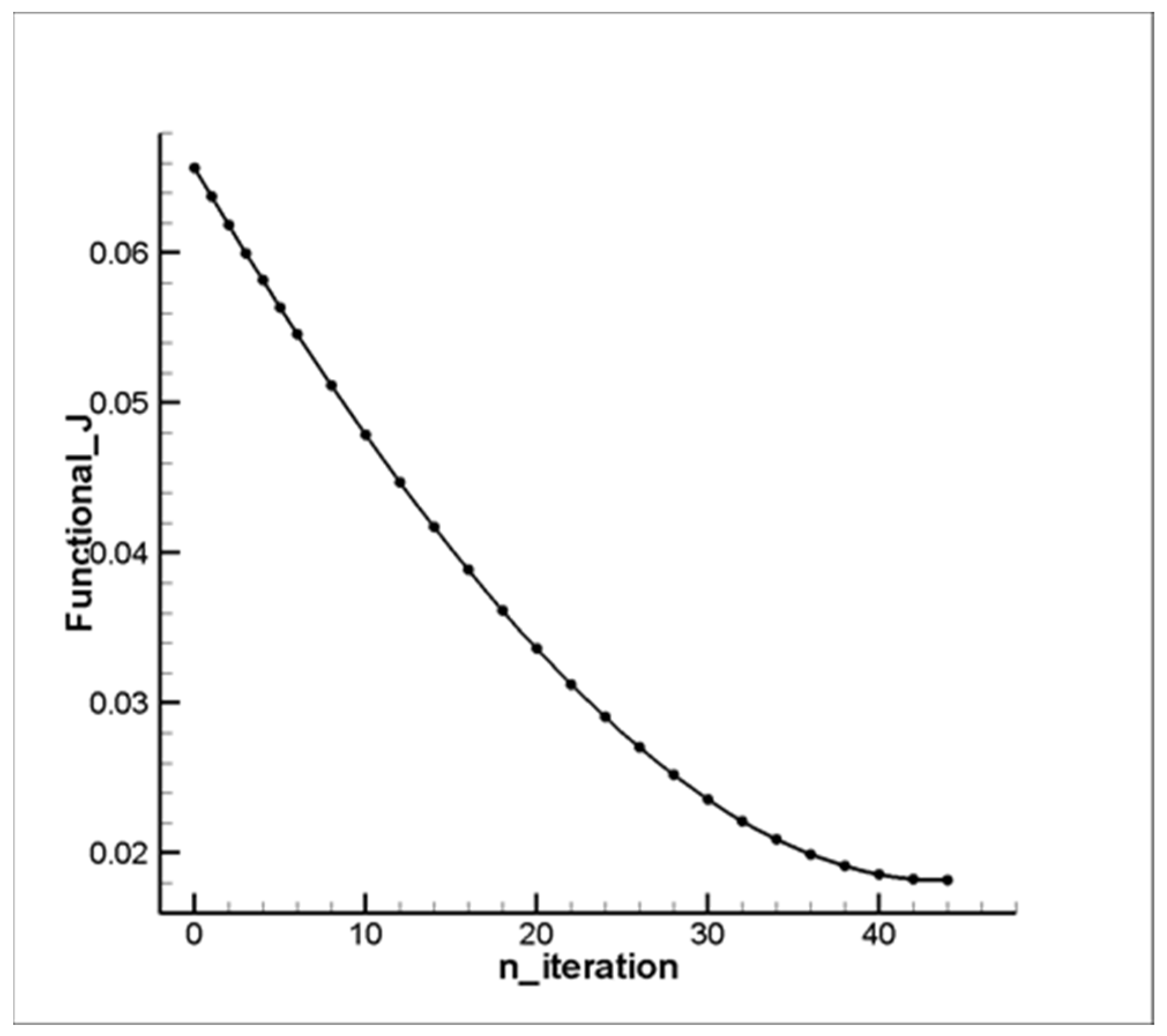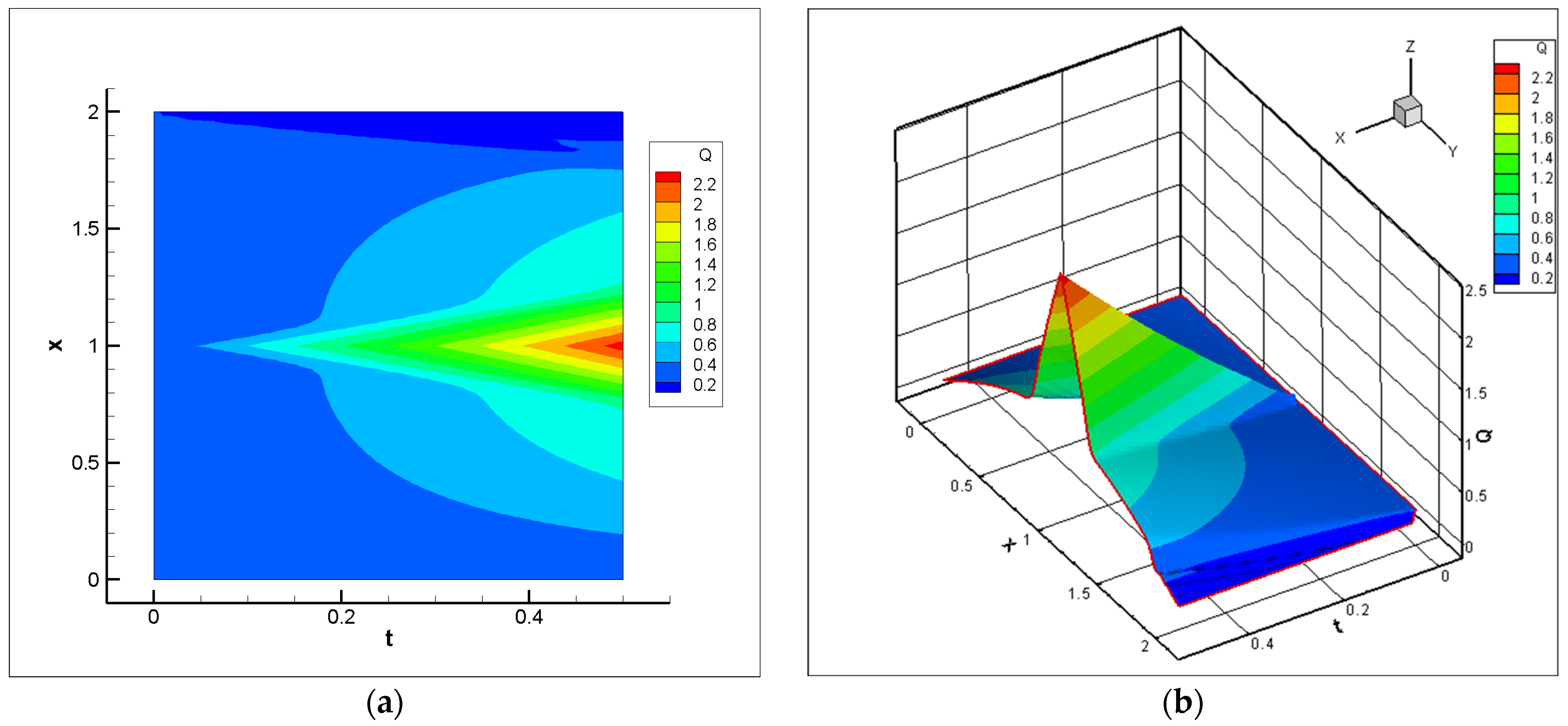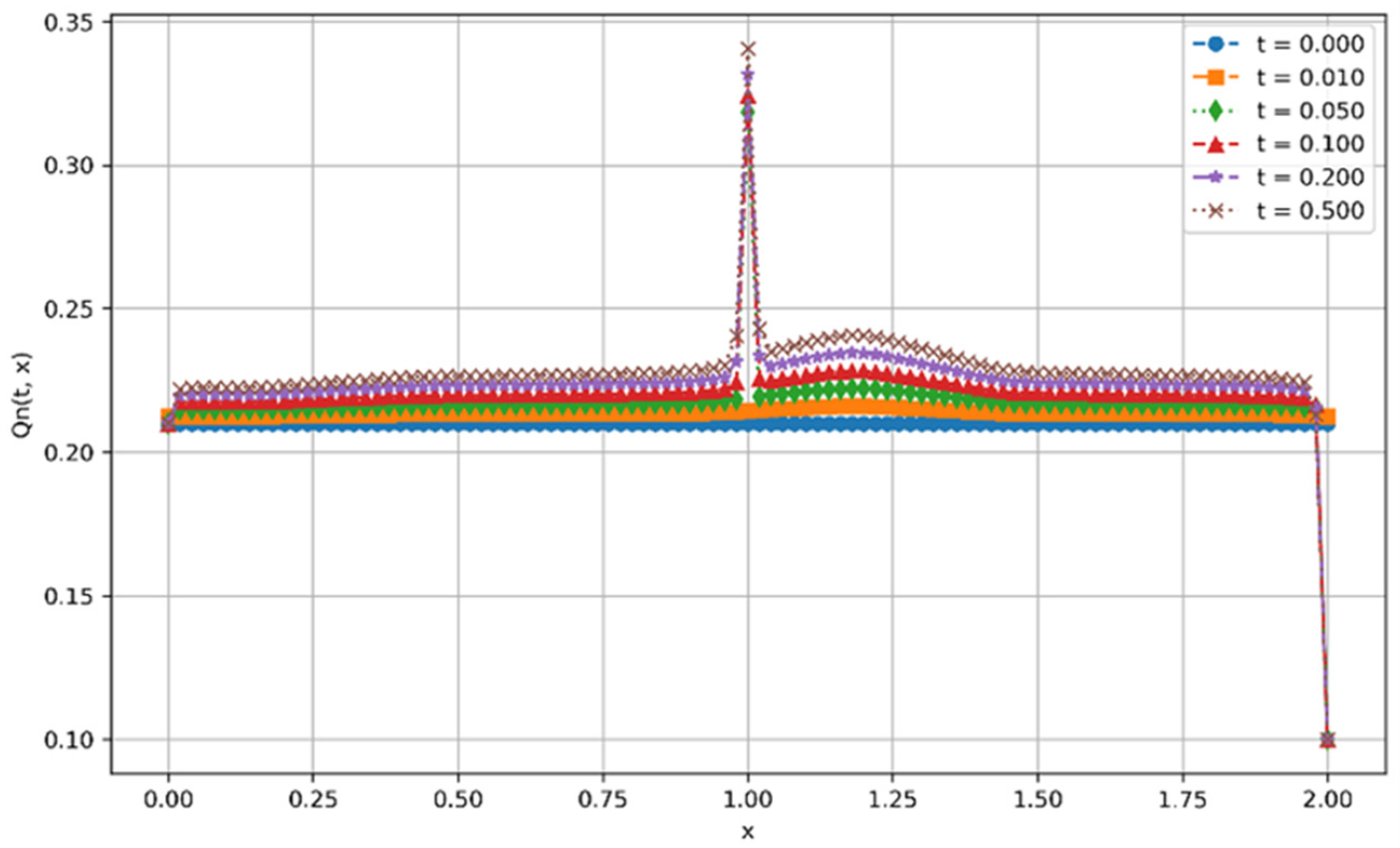Numerical Solution of the Direct and Inverse Problems in the Gas Lift Process of Oil Production Using the Conjugate Equations Method
Abstract
1. Introduction
2. Materials and Methods
2.1. Statement of Direct and Inverse Problems
2.2. Statement of the Variational Problem
- Let us consider the variation of the functional, , under the perturbation, .
- We introduce the perturbed solution, , and define
- We perform a convolution of the variation through the unknown function, satisfying the following conjugate equation:
- 4.
- Then, the Frechet derivative of the functional takes the following the form:
2.3. Landweber Algorithm (Simple Iteration Method)
- We set the initial approximation, .
- Suppose that is already known; then, we solve the direct problem (9)–(12).
- Calculate the value of the following functional:
- If the current value of the functional, , is not small enough, solve the conjugate problem (16)–(18).
- Calculate the gradient of the following functional:
- Calculate the following approximation:
2.4. Numerical Solutions for the Direct and Conjugate Problem
2.4.1. Scheme for Solving a Direct Problem
2.4.2. A Scheme for Solving the Conjugate Problem
2.5. Study of the Approximation and Stability of a Family of Difference Schemes
3. Results and Discussion
Numerical Solution for the Problem
Computational Experiment
4. Conclusions
- -
- Reduce the volume of gas consumed while maintaining the production level.
- -
- Adapt control to changing reservoir and well characteristics.
- -
- Increase operating efficiency without the need to install additional sensors.
- -
- Predict and minimize the risks of underloading or the over-consumption of gas.
Author Contributions
Funding
Data Availability Statement
Conflicts of Interest
Appendix A
References
- Aliyev, F.A.; Mutalimov, M.M. Algorithm for solving the trajectory construction and control problem in gas-lift oil production. In Report of the National Academy of Sciences of Azerbaijan; National Academy of Sciences of Azerbaijan: Baku, Azerbaijan, 2009. [Google Scholar]
- Mehregan, M.R.; Mohaghar, A.; Esmaeili, A. Developing a mathematical model for optimizing oil production using gas-lift technology. Int. J. Eng. Res. Appl. 2016, 9, 24–32. [Google Scholar]
- Jung, S.-Y.; Lim, J.-S. Optimization of gas lift allocation for improved oil production under facilities constraints. Geosyst. Eng. 2016, 19, 39–47. [Google Scholar] [CrossRef]
- Lions, J.L. Optimal Control of Systems Governed by Partial Differential Equations; Springer: Berlin/Heidelberg, Germany, 1971. [Google Scholar]
- Lions, J.L.; Magenes, E. Non-Homogeneous Boundary Value Problems and Applications; Springer: Berlin/Heidelberg, Germany, 1972; Volume II. [Google Scholar]
- Agoshkov, V.I. Optimal Control Methods and the Method of Conjugate Equations in Problems of Mathematical Physics; Institute of Higher Mathematics RAS: Moscow, Russia, 2003; 256p. [Google Scholar]
- Marchuk, G.I. Conjugate Equations and Their Applications. Proc. IMM URO RAS 2006, 12, 184–195. [Google Scholar]
- Il’in, V.A.; Moiseev, E.I. Optimization of boundary controls by displacements at two ends of a string during an arbitrary sufficiently large time interval. Dokl. Math. 2007, 76, 828–834. [Google Scholar]
- Temirbekov, A.N.; Temirbekova, L.N.; Zhumagulov, B.T. Fictitious domain method with the idea of conjugate optimization for non-linear Navier-Stokes equations. Appl. Comput. Math. 2023, 22, 172–188. [Google Scholar] [CrossRef]
- Kasenov, S.E.; Tleulesova, A.M.; Sarsenbayeva, A.E.; Temirbekov, A.N. Numerical Solution of the Cauchy Problem for the Helmholtz Equation Using Nesterov’s Accelerated Method. Mathematics 2024, 12, 2618. [Google Scholar] [CrossRef]
- Arguchintsev, A.V.; Poplevko, V.P. An optimal control problem by hyperbolic system with boundary delay. Bulletin of Irkutsk State University. Mathematics 2021, 35, 3–17. [Google Scholar] [CrossRef]
- Arguchintsev, A.V.; Krutikova, O.A. Optimization of semilinear hyperbolic systems with smooth boundary controls. Russ. Math. (Izv. VUZ) 2021, 45, 1–9. [Google Scholar]
- Shishlenin, M.; Kozelkov, A.; Novikov, N. Nonlinear medical ultrasound tomography: 3D modeling of sound wave propagation in human tissues. Mathematics 2024, 12, 212. [Google Scholar] [CrossRef]
- Klyuchinskiy, D.; Novikov, N.; Shishlenin, M. Recovering density and speed of sound coefficients in the 2D hyperbolic system of acoustic equations of the first order by a finite number of observations. Mathematics 2021, 9, 199–211. [Google Scholar] [CrossRef]
- Novikov, N.; Shishlenin, M. Direct method for identification of two coefficients of acoustic equation. Mathematics 2023, 11, 3029. [Google Scholar] [CrossRef]
- Kabanikhin, S.I.; Karchevsky, A.L. Optimizational method for solving the Cauchy problem for an elliptic equation. J. Inverse Ill-Posed Probl. 1995, 3, 21–46. [Google Scholar] [CrossRef]
- Kim, J.; Cho, M.-K.; Jung, M.; Kim, J.; Yoon, Y.-S. Rotary hearth furnace for steel solid waste recycling: Mathematical modeling and surrogate-based optimization using industrial-scale yearly operational data. Chem. Eng. J. 2023, 464, 142619. [Google Scholar] [CrossRef]
- Kasenov, S.; Askerbekova, J.; Tleulesova, A. Algorithm construction and numerical solution based on the gradient method of one inverse problem for the acoustics equation. East.-Eur. J. Enterp. Technol. 2022, 2, 116. [Google Scholar]
- Temirbekov, N.; Temirbekov, A.; Kasenov, S.; Tamabay, D. Numerical Modeling for Enhanced Pollutant Transport Prediction in Industrial Atmospheric Air. Int. J. Des. Nat. Ecodyn. 2024, 19, 917–926. [Google Scholar] [CrossRef]
- Kabanikhin, S.I. Inverse and Ill-Posed Problems; Siberian Scientific Publishing: Novosibirsk, Russia, 2009; 458p. [Google Scholar]
- Samarskii, A.A. Theory of Difference Schemes; Nauka: Moscow, Russia, 1989; 654p. [Google Scholar]





Disclaimer/Publisher’s Note: The statements, opinions and data contained in all publications are solely those of the individual author(s) and contributor(s) and not of MDPI and/or the editor(s). MDPI and/or the editor(s) disclaim responsibility for any injury to people or property resulting from any ideas, methods, instructions or products referred to in the content. |
© 2025 by the authors. Published by MDPI on behalf of the International Institute of Knowledge Innovation and Invention. Licensee MDPI, Basel, Switzerland. This article is an open access article distributed under the terms and conditions of the Creative Commons Attribution (CC BY) license (https://creativecommons.org/licenses/by/4.0/).
Share and Cite
Temirbekov, N.M.; Turarov, A.K.; Kasenov, S.E. Numerical Solution of the Direct and Inverse Problems in the Gas Lift Process of Oil Production Using the Conjugate Equations Method. Appl. Syst. Innov. 2025, 8, 47. https://doi.org/10.3390/asi8020047
Temirbekov NM, Turarov AK, Kasenov SE. Numerical Solution of the Direct and Inverse Problems in the Gas Lift Process of Oil Production Using the Conjugate Equations Method. Applied System Innovation. 2025; 8(2):47. https://doi.org/10.3390/asi8020047
Chicago/Turabian StyleTemirbekov, Nurlan M., Amankeldy K. Turarov, and Syrym E. Kasenov. 2025. "Numerical Solution of the Direct and Inverse Problems in the Gas Lift Process of Oil Production Using the Conjugate Equations Method" Applied System Innovation 8, no. 2: 47. https://doi.org/10.3390/asi8020047
APA StyleTemirbekov, N. M., Turarov, A. K., & Kasenov, S. E. (2025). Numerical Solution of the Direct and Inverse Problems in the Gas Lift Process of Oil Production Using the Conjugate Equations Method. Applied System Innovation, 8(2), 47. https://doi.org/10.3390/asi8020047






